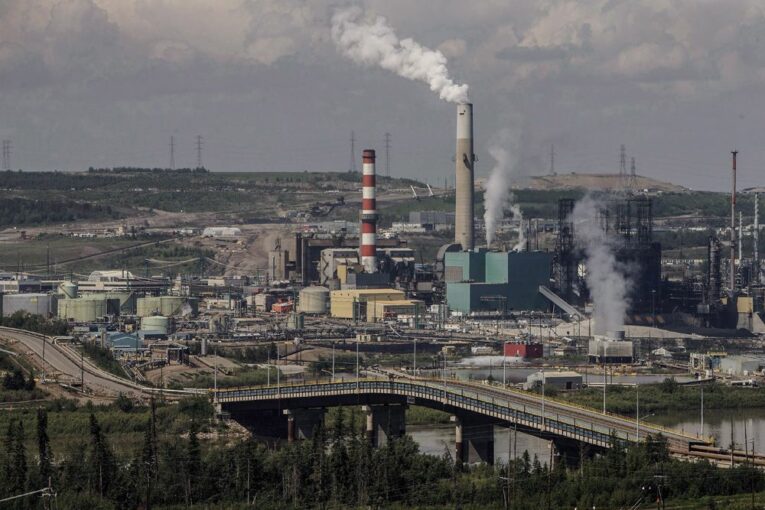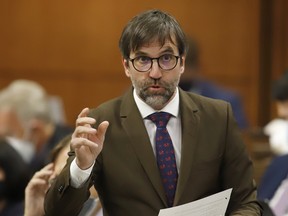
The oilpatch has been rattled by concerns that the federal government’s proposed cap on oil and gas emissions could force the industry to curtail production in order to stay within a regulated limit by the end of the decade.
The federal government said this week that it is considering two options to drive down emissions in order to meet its climate promises: a cap-and-trade system with a set number of allowances distributed to oil and gas facilities, or a modified carbon-pricing system that could see the industry pay a higher carbon price.
So far, Prime Minister Justin Trudeau’s government hasn’t indicated where the ceiling on emissions could be set, but a new discussion paper on the proposed cap is causing a stir among the country’s oil producers.
According to the paper, which was published July 18 by Environment Minister Steven Guilbeault, emissions must not increase from current levels (around 191 million tonnes of carbon dioxide equivalent in 2019), and a cap will have to account for targets set out in the government’s Emissions Reduction Plan, which calls for 110 million tonnes by 2030 — equivalent to a 42 per cent cut from 2019 levels.
“We think it’s probably not realistic that the sector could achieve that level of reduction,” said Mark Cameron, vice-president of the Pathways Alliance, a key group of energy companies that account for 95 per cent of production in the Alberta oilsands.
We think it’s probably not realistic that the sector could achieve that level of reduction
Mark Cameron
“The biggest risk is if we just can’t comply and don’t have the mechanisms that allow us to comply, that we would have to shut in production as opposed to investing in technology to reduce emissions.”
A lot is riding on the design of the proposed cap, which could have significant implications for the Canadian economy over the next decade. Canada’s oil and gas industry accounts for an outsized share of the country’s export revenue, but also an outsized share of emissions — about a quarter of the national total.
So, the Trudeau government is under pressure to set stringent targets in the service of its net-zero climate objectives. Some environmental groups are urging the government to impose a hard cap on emissions that would result in production cuts and the eventual phasing out of oil and gas extraction — a view at odds with an approach that would incentivize producers to invest in emissions reduction technologies like carbon capture, utilization and storage (CCUS).

Some energy investors say they’re skeptical the industry will be able to meet the federal government’s 2030 emissions targets since CCUS technology — viewed as key to achieving deep emissions cuts from the sector — is expensive and slow to build.
Eric Nuttall, a partner and senior portfolio manager at Ninepoint Partners LP, said the Liberal 2030 emissions plan would require the energy sector to reduce emissions to the level they were at in 1992, when the country produced about four million barrels of oil equivalent (boe) per day.
Canada is currently producing about 7.8 million boe per day, Nuttall said.
“At best, it’s a cap on Canadian oil production and at worst, it’s going to force production declines,” Nuttall said. “From a producer’s perspective… there’s nothing in the short term to meaningfully reduce emissions intensity other than CCUS, which is beyond 2030.”
At best, it’s a cap on Canadian oil production and at worst, it’s going to force production declines
Eric Nuttall
Members of the Pathways Alliance are in the process of evaluating a $14-billion CO2 trunk line and sequestration hub project in northern Alberta, as well as the deployment of solvents and electrification of production to drive down emissions.
But the group has also been at odds with the Trudeau government over what constitutes a realistic pace and scale for decarbonization.
“We have a very detailed plan to achieve a 22-megatonne absolute reduction by 2030 with the existing regulations in place,” Cameron said. “So adding new regulations — it doesn’t change the laws of physics, we won’t be able to go faster than 22 megatonnes. It just it just makes the compliance with with federal regulation that much more difficult.”
Proponents of decarbonation within the sector are urging the federal government to emphasize demand-side mitigation strategies, such as carbon taxes and electric-vehicle infrastructure expansion, rather than regulating the extraction of fossil fuels.
Canada’s top oil and gas lobby group, the Canadian Association of Petroleum Producers (CAPP), also criticized the Trudeau government’s proposal for focussing too narrowly on the sector, and for eliminating options for economy-wide co-operation on emissions cuts. CAPP said earlier this week that a cap on oil and gas emissions could “work against” the progress the country has made in balancing climate goals and energy security and hurt Canada’s allies.
The federal government, for its part, has argued the proposed cap is on emissions, not oil and gas production. Nuttall, for one, is unconvinced by that argument, countering that Trudeau has ignored other large-emitting sectors such as transportation, while targeting oil production.
“You’re basically saying you’re going to penalize those who are producing it, but not penalizing those who are consuming it,” Nuttall said. “And if we’re impairing production growth, then you’re basically gonna have to abdicate market share to other countries who do not share our leading environmental standards. I think it needs a lot more rethinking.”
• Email: [email protected] | Twitter: mpotkins
You can read more of the news on source
